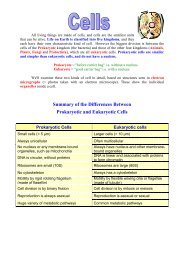Continuous and discontinuous variation - BiologyMad A-Level Biology
Continuous and discontinuous variation - BiologyMad A-Level Biology
Continuous and discontinuous variation - BiologyMad A-Level Biology
You also want an ePaper? Increase the reach of your titles
YUMPU automatically turns print PDFs into web optimized ePapers that Google loves.
Natural selection<br />
The Hardy-Weinberg equation requires such stringent<br />
conditions to be met, that, in the real world, it is seldom, if<br />
ever, true. Thus, the equation is used to show that<br />
populations change over time, something we normally call<br />
evolution.<br />
The driving force behind evolution is natural selection, <strong>and</strong><br />
this can occur in three main ways:<br />
Stabilising selection:<br />
This is the most common, <strong>and</strong> is a response to a stable<br />
environment. A good example is birth weight, since underweight<br />
babies are clearly less likely to survive, <strong>and</strong> overweight<br />
babies are likely to get stuck during birth, killing not<br />
only themselves, but also their mothers! The result is that<br />
the mode stays the same, but the SD of the population<br />
falls, i.e. the population graph gets narrower <strong>and</strong> taller, as<br />
selection against mutations takes place. This is most<br />
apparent in small, isolated populations, or when a bottleneck<br />
event takes place.<br />
Directional selection:<br />
A bottleneck event occurs when a population is reduced to<br />
just a few breeding individuals (e.g. cheetahs). Though the<br />
total population may later recover, they will all be<br />
descendants of the few originals (Adam <strong>and</strong> Eve?) <strong>and</strong> so<br />
will have a much narrower gene pool than the original<br />
population.<br />
There have been a number of events in geological history<br />
(‘mass extinctions’) when all forms of life on Earth were<br />
reduced to around 1% of the previous community. These<br />
events are followed by rapid evolution <strong>and</strong> an increase<br />
in diversity, as species evolve to fill every available niche.<br />
The last such event was 65 million years ago, when the<br />
Dinosaurs became extinct, allowing mammals to replace<br />
reptiles as the dominant life-forms on Earth.<br />
This is the most common form of selection that results in a population with<br />
a new trait. It takes place whenever change occurs in the environment,<br />
such as when a poison is used <strong>and</strong> resistant<br />
individuals begin to occur. These soon<br />
become the dominant type within the<br />
population. It does not matter if the<br />
example is Warfarin resistance in rats,<br />
DDT resistance in mosquitoes, or antibiotic<br />
resistance in bacteria. In Nature, such<br />
selection can also occur, as we saw, in<br />
spine selection in Holly, or when cacti are<br />
grazed (see left):
















